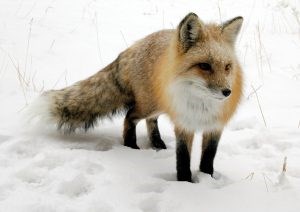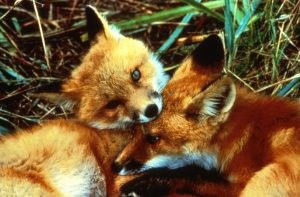This content was originally published by the Longmont Observer and is licensed under a Creative Commons license.
There are several places in Longmont where red foxes make their home, completely comfortable in suburbia. I can remember the day I was running at Centennial Park a few years ago and was privileged to see a fox sitting on the grass by the track. Often thought of as a cunning animal, Colorado is actually home to four different species of foxes: red foxes, grey foxes, kit foxes, and swift foxes. The species most likely to be found in Longmont is the red fox.
The red fox is the largest of the true foxes. They are about the size of a small dog, between five and seven pounds. Red foxes are between three and three and a half feet long, and males tend to be a bit bigger than the females. Males are referred to as dogs and females as vixens. Although the fur can be variable in color, it is usually a flame-red color that changes to white or black on the underbelly. The lower limbs are often black as are the backs of the ears. The tail is very bushy and may be tipped with white or black. Incidentally, the fox’s tail is called a brush and can be used to help keep the fox warm in the winter. Red foxes have yellow eyes and a black nose.

Red foxes are the most widely distributed carnivores in the world and do especially well where wolves are absent. They can be found in very diverse habitats ranging from riparian woodlands and wetlands to forest-edge communities closer to the mountains. As mentioned, they can also be found in urban environments because they are a highly adaptable species. Foxes will maintain a territory that they use for most of their daily activities called a home range. Home ranges can be up to five miles in diameter and are usually elliptical in shape.
Red foxes primarily eat rodents, rabbits, and birds. However, foxes are essentially omnivores, and will also eat insects, fruit, and dead animals. They are most active at dawn and at dusk. There are any number of videos that show how foxes hunt mice that are quite entertaining. When hunting mice, the fox will stand still in one place listening and watching. Once it detects a mouse, the fox will jump high in the air and bring its forelimbs straight down, pinning the mouse to the ground.
Red foxes may store their food and they are quite adept at finding their food stores again. During the winter, they will mainly eat meat and during the summer their primary food consists of insects and fruit. Red foxes are known to prefer blueberries, raspberries, and black cherries. They play an important role in the ecosystem by keeping rodent and rabbit populations down and dispersing seeds.

Pups are also known as cubs or kits. Pups are born in a den which consists of a burrow abandoned by another animal and enlarged by the parents. Dens may be reused year after year. The pups will remain in the den for about five weeks, during which time both parents care for them. At first, the female stays in the den and the male brings her food, but does not go into the den. At about eight to twelve weeks of age, the pups start tagging along with their parents on hunting trips. By 18-20 weeks of age the pups can fend for themselves although they will likely remain with their parents for the first couple weeks after that. The pups disperse in the fall.
Red foxes use a variety of methods to communicate with each other. They are capable of producing up to 28 different vocalizations and each individual fox has a clearly distinguishable voice. Red foxes produce a screeching yowl that is often mistaken for house cats fighting. They also bark, yip, and howl although the howl of a fox is very different from that of a coyote or wolf. They also use facial expressions. Scent marking is another important way foxes communicate with each other and they may use urine, feces, anal glands, and glands in their face and paws to scent mark.

One of the traits that makes the red fox less than endearing to some people is their ability to prey on chickens and even house cats. Foxes can be enjoyed from a distance. If one appears in your neighborhood that you do not want, there are several things you can do to discourage them from setting up shop. Make sure to store garbage in covered containers. Wildlife-proof garbage containers are best. If you have a compost heap, avoid putting meat or fruit scraps on it as this will attract foxes. Clean up any fruit that has fallen. Keep pets indoors or in a fenced yard. When walking your dog, make sure it is on a leash. Above all, don’t feed foxes. It is illegal and it is harmful to the animal. In addition, it can habituate the fox to humans and make the risk of a bite more likely. If you are lucky enough to spot one of these beautiful creatures, remember to watch them from a distance. If the animal starts watching you or begins acting nervously, you may be too close.


